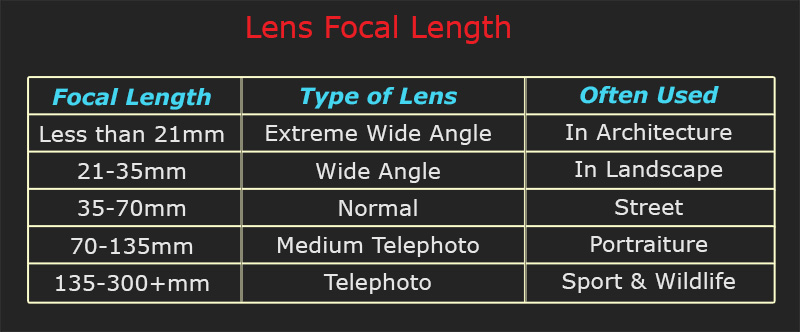In this photography tutorial I will make a general overview of Nikon and Canon lenses.
You will learn what all those numbers and letters on the lens and in the lens name mean. We will be talking about Focal Length, Fixed and Variable Apertures, Crop and Full Frame sensor lenses, ED glass and Nano Crystal Coating Canon L lenses and much more.
SOME INFO FROM THE VIDEO:
Lenses might differ by they focal length.
They can also be Zoom (changeable focal length) or Prime (fixed focal length) lenses.
One of important aspects of the lens is its maximum aperture. Ofter fixed focal length lenses have wider maximum aperture. Zoom lenses also might have variable maximum aperture, which will change together with its focal length. Zoom lenses with fixed aperture are usually better and more expensive.
On some lenses you might also see VR – vibration reduction (Nikon) or IS – image stabilization (Canon).
VR or IS is an image stabilization technology that minimizes blur caused by camera shake. You can experience camera shake by holding the camera and using slower shatter speeds. It is not recommended to use shatter speed slower then 1/focal length of the lens while holding the camera, but with VR/IS you can go about 3 stops slower. Of course it all also depends on photographer and how sturdy he/she is.
There are lenses which are make for full or cropped sensor:
For Nikon: DX (Crop Sensor) and FX (Full Frame)
For Canon: EF-S (Crop Sensor) and EF (Full Frame)
Click here to learn more about full and cropped sensor.
Nikon also have G and D lenses. The mail different is that D lenses have an aperture ring and can be easily used with old cameras. On other hand G lenses don’t have aperture ring and can’t be used with old cameras.
But you have to be careful while choosing D lens, because a lot of them have AF instead of AF-S focusing system.
AF lenses use a screwdriver focus mechanism. In this case focusing has to be controlled by the camera motor.
AF-S lenses have the focus motor built into the lens (much quieter and faster).
Bodies that are AFS only will not autofocus with regular AF lenses.
AF lens will not autofocus with:
D5200, D5100, D5000, D3200, D3100, D3000, D60, D40, D40x
AF will autofocus with:
D800, D800E, D700, D600, D300s, D300, D200, D7000, D7100, D90, D80, D70, D70s, D50, D100
You also might hear about Nikon lenses with ED (Extra-low Dispersion) Glass. It actually help to correct chromatic aberrations, or optical color defects.
Some Nikon lenses also have Nano Crystal Coat, which helps to eliminate or minimize Ghost and Flare.
On other hand Canon has a professional like of L lenses.
L=”Luxury” or “Low Dispersion”
There usually are:
– heavier and tough buil
– most are weather sealed
– will work on all film and digital Canons of all formats
– typically have wider fixed apertures
– have USM (ultrasonic motor), which allow faster and quiter focusing
– minimize chromatic aberration – produce better colors

Hello Oksana,
Even though all my previous comments were one worders, they are meant as said. I have been watching and learning from your videos since I first found you on Youtube back in 2011. I have ALL your teaching Vids on my PC, Laptop, Tablet and Mobile Phone, so they go with me everywhere. Your videos are my number one GoTo when I need something answered when I am out and about.
You have an excellent presentation manner, great knowledge and a special warmth in your commitment. I am extremely happy to have been an early member and I have to admit to have been remiss in my lack of activity on the site, but have been extremely busy over the past 10 months with different things and am now back to relaxing with my favourite hobby, Photography.
Keep up the lovely work Oksana and have a great year.
Thank you for lovely comment! It makes me so happy to hear that you are back! We really missed you!I wish you a great year as well!
Dear Oksana,
In fact, I am of the people like your profile and how to raise issues photographic. I hope that to be active participants with the group in the future .I will try to share the images for my Village Qatife – country ( Saudi Arabia ) , a beautiful coastal city is very famous for its handmade industries and agriculture and fishing
sure i will post near some pictures .
best regards,
Fouad Al-Basha
really…a good one…helpful ….watching all your lessons….
thank you
Hi Oksana
I have only just found your utube lessons and had watch lesson 1 to 30 in the last 2 weeks. Although I had not grasp all the information so far (sooo much to learn..) I actually learned and understood basic photography from your tutorials compared to all the books, manuals and dvd’s I had purchased to learn how to take good photos. I am a beginner and owned Nikon 3100. My passion is to learn macros and candid photography. At present I have just been using auto function which does not really produce the picture I wanted to capture. Would you mind showing a lesson about macro photography in the future. Your lessons are really easy to follow and comprehensive! Thank you very much for your passion and helping us understood photography. I can’t wait to try a bit of your lessons soon. Best regards Ptgrphy
I am very happy to hear that, Ptgrphy. Yes, I will be having a lesson on macro photography soon.